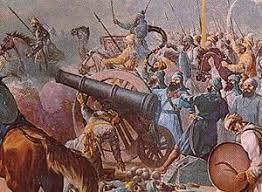Battle Of Multan:
In early 1818, Ranjit Singh ordered the Sikh army to rendezvous on the south-west frontier of the Sikh Empire to make preparations for an expedition against Multan. By January 1818, the Sikh Empire had established an extensive supply chain from the capital, Lahore, to Multan, with the use of boat transports to ferry supplies across the Jhelum, Chenab, and Ravi rivers. Rani Raj Kaur (Mai Nakkain) was given the command of the battle additionally she, herself oversaw the steady supply of grain, horses, and ammunition being sent to the at Kot Kamalia, a town equally distanced between Multan and Lahore.
In early January the Sikh force began their campaign with the capture of Nawab Muzaffar Khan's forts at Muzaffargarh and Khangarh. In February, the Sikh force under Kharak Singh reached Multan and ordered Muzaffar to pay the large tribute he owed and to surrender the fort, but Muzaffar refused. The Sikh forces won an engagement near the city but were unable to capture Muzaffar before he retreated into the fort. The Sikh army asked for more artillery and Ranjit Singh sent them the Zamzama and other large artillery pieces, which commenced fire on the walls of the fort. In early June, Sadhu Singh and a small band of other Akalis attacked the fort walls and discovered a breach in the wall. As they ran in to battle the unaware garrison the larger Sikh army was alerted and entered the fort through the breach. Muzaffar and his sons attempted a sortie to defend the fort but were killed in the battle.
The siege of Multan ended significant Afghan influence in the Peshawar region and led to capture of Peshawar by Sikhs.
In early 1818, Ranjit Singh ordered the Sikh army to rendezvous on the south-west frontier of the Sikh Empire to make preparations for an expedition against Multan. By January 1818, the Sikh Empire had established an extensive supply chain from the capital, Lahore, to Multan, with the use of boat transports to ferry supplies across the Jhelum, Chenab, and Ravi rivers. Rani Raj Kaur (Mai Nakkain) was given the command of the battle additionally she, herself oversaw the steady supply of grain, horses, and ammunition being sent to the at Kot Kamalia, a town equally distanced between Multan and Lahore.
In early January the Sikh force began their campaign with the capture of Nawab Muzaffar Khan's forts at Muzaffargarh and Khangarh. In February, the Sikh force under Kharak Singh reached Multan and ordered Muzaffar to pay the large tribute he owed and to surrender the fort, but Muzaffar refused. The Sikh forces won an engagement near the city but were unable to capture Muzaffar before he retreated into the fort. The Sikh army asked for more artillery and Ranjit Singh sent them the Zamzama and other large artillery pieces, which commenced fire on the walls of the fort. In early June, Sadhu Singh and a small band of other Akalis attacked the fort walls and discovered a breach in the wall. As they ran in to battle the unaware garrison the larger Sikh army was alerted and entered the fort through the breach. Muzaffar and his sons attempted a sortie to defend the fort but were killed in the battle.
The siege of Multan ended significant Afghan influence in the Peshawar region and led to capture of Peshawar by Sikhs.
Battle Of Multan:
In early 1818, Ranjit Singh ordered the Sikh army to rendezvous on the south-west frontier of the Sikh Empire to make preparations for an expedition against Multan. By January 1818, the Sikh Empire had established an extensive supply chain from the capital, Lahore, to Multan, with the use of boat transports to ferry supplies across the Jhelum, Chenab, and Ravi rivers. Rani Raj Kaur (Mai Nakkain) was given the command of the battle additionally she, herself oversaw the steady supply of grain, horses, and ammunition being sent to the at Kot Kamalia, a town equally distanced between Multan and Lahore.
In early January the Sikh force began their campaign with the capture of Nawab Muzaffar Khan's forts at Muzaffargarh and Khangarh. In February, the Sikh force under Kharak Singh reached Multan and ordered Muzaffar to pay the large tribute he owed and to surrender the fort, but Muzaffar refused. The Sikh forces won an engagement near the city but were unable to capture Muzaffar before he retreated into the fort. The Sikh army asked for more artillery and Ranjit Singh sent them the Zamzama and other large artillery pieces, which commenced fire on the walls of the fort. In early June, Sadhu Singh and a small band of other Akalis attacked the fort walls and discovered a breach in the wall. As they ran in to battle the unaware garrison the larger Sikh army was alerted and entered the fort through the breach. Muzaffar and his sons attempted a sortie to defend the fort but were killed in the battle.
The siege of Multan ended significant Afghan influence in the Peshawar region and led to capture of Peshawar by Sikhs.
0 Комментарии
0 Поделились
0 предпросмотр





